(完整)新版-人教版七年级英语下册第三单元教案
人教版英语七年级下册 Unit 3大单元教学设计
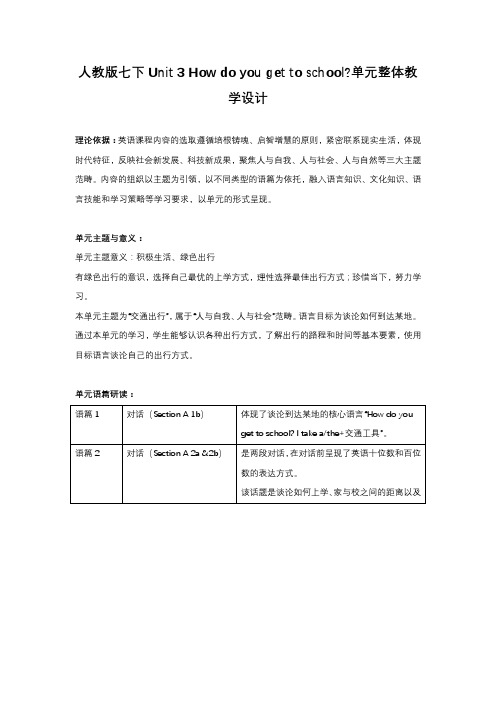
人教版七下Unit 3 How do you get to school?单元整体教学设计理论依据:英语课程内容的选取遵循培根铸魂、启智增慧的原则,紧密联系现实生活,体现时代特征,反映社会新发展、科技新成果,聚焦人与自我、人与社会、人与自然等三大主题范畴。
内容的组织以主题为引领,以不同类型的语篇为依托,融入语言知识、文化知识、语言技能和学习策略等学习要求,以单元的形式呈现。
单元主题与意义:单元主题意义:积极生活、绿色出行有绿色出行的意识,选择自己最优的上学方式,理性选择最佳出行方式;珍惜当下,努力学习。
本单元主题为“交通出行”,属于“人与自我、人与社会”范畴。
语言目标为谈论如何到达某地。
通过本单元的学习,学生能够认识各种出行方式,了解出行的路程和时间等基本要素,使用目标语言谈论自己的出行方式。
单元语篇研读:单元整体设计框架图:单元教学目标:语言能力:1.能正确使用有关交通出行的词汇和语块。
2. 能熟练运用how, how long, how far 引导的特殊疑问句和答语来谈论出行方式、耗时和距离。
文化意识:1. 能认识中外文化之间有关健康出行和珍爱亲情的相似之处。
2. 能理解不同的出行方式背后的地域文化差异。
思维品质:1.能多角度、辩证地看待事物和分析问题。
2. 能推断语篇的深层含义,作出正确的价值判断。
学习能力:1. 能根据语块记忆词汇。
2. 能在听中抓关键信息并用阿拉伯数字帮助速记。
3. 能根据语篇的问题特征快速提取关键信息。
基于主题意义的课时教学目标:Unit 3 How do you get to school? 教学设计Section B 2a-2e ReadingPeriod 4单元教材分析:本单元以“谈论出行方式“为语言目标,紧紧围绕单元主题绿色出行展开,通过本单元的学习,学生能够认识各种出行方式,了解出行的路程和时间等基本要素,使用目标语言谈论自己的出行方式。
本单元共设计五个课时,通过每个课时的环环相扣,最终完成单元整体教学目标,以下为本单元第四课时阅读课的教学设计。
七年级英语下册第三单元教案(新人教版)

七年级英语下册第三单元教案(新人教版)教学目标1.学习掌握与购物相关的词汇与表达方式。
2.学会询问价格和询问并给予建议。
3.能够运用所学知识进行口语练习和书写练习。
教学重点1.学习购物相关的词汇。
2.学会用英语询问价格和给予建议。
教学难点1.如何运用所学知识进行口语练习。
2.如何在实际情境中进行购物对话。
教学准备1.教材:新人教版七年级英语下册。
2.多媒体设备。
教学过程导入(5分钟)1.利用多媒体展示一些不同商品的图片,通过简单提问引导学生进入课堂主题。
2.引导学生讨论以下问题:What can you buy in a store? How do you ask the price? How do you bargain?学习新知(20分钟)1.呈现与购物有关的词汇,并利用多媒体进行配图,帮助学生理解词汇的意义。
词汇包括:price, discount, cashier, customer, etc.2.向学生介绍并练习询问价格的句型,例如:How much is it? 或者How much does it cost?3.向学生介绍并练习给予建议的句型,例如:I think you should buy… 或者Wh y don’t you try…?4.利用多媒体进行示范,让学生模仿老师的语音、语调和表达方式。
情境对话(15分钟)1.学生分成小组,每组两人,一人扮演顾客,一人扮演售货员。
2.学生根据所给的商品图片进行情境对话,练习询问价格和给予建议。
3.在对话的过程中,教师可以巡视并指导学生,纠正他们的语音和语法错误。
讨论与练习(15分钟)1.教师提出一些与购物相关的问题,例如:What’s your favorite store? How often do you go shopping? Do you prefer shopping online or in stores?2.学生利用所学句型进行回答,并互相组织小组讨论。
完整新版 人教版七年级英语下册第三单元教案
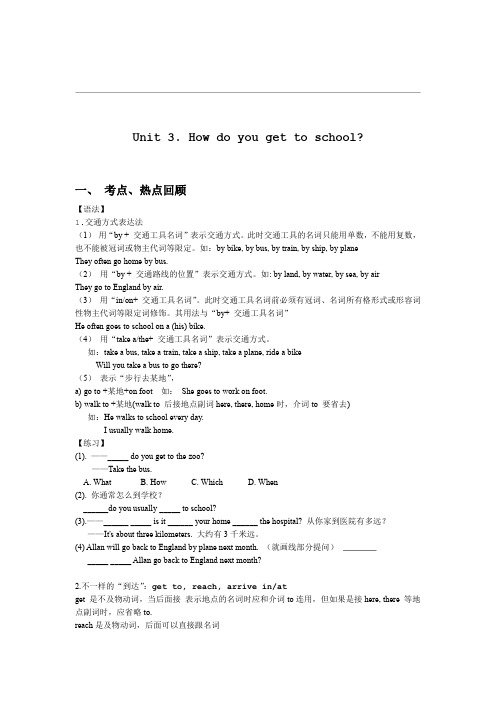
Unit 3. How do you get to school?一、考点、热点回顾【语法】1.交通方式表达法(1)用“by + 交通工具名词”表示交通方式。
此时交通工具的名词只能用单数,不能用复数,也不能被冠词或物主代词等限定。
如:by bike, by bus, by train, by ship, by planeThey often go home by bus.(2)用“by + 交通路线的位置”表示交通方式。
如: by land, by water, by sea, by airThey go to England by air.(3)用“in/on+ 交通工具名词”。
此时交通工具名词前必须有冠词、名词所有格形式或形容词性物主代词等限定词修饰。
其用法与“by+ 交通工具名词”He often goes to school on a (his) bike.(4)用“take a/the+ 交通工具名词”表示交通方式。
如:take a bus, take a train, take a ship, take a plane, ride a bikeWill you take a bus to go there?(5)表示“步行去某地”,a)go to +某地+on foot 如:She goes to work on foot.b)walk to +某地(walk to 后接地点副词here, there, home时,介词to 要省去)如:He walks to school every day.I usually walk home.【练习】(1). ——_____ do you get to the zoo?——Take the bus.A. WhatB. HowC. WhichD. When(2). 你通常怎么到学校?______do you usually _____ to school?(3).——______ _____ is it ______ your home ______ the hospital? 从你家到医院有多远?——It's about three kilometers. 大约有3千米远。
人教版七年级英语下册Unit3大单元教学设计
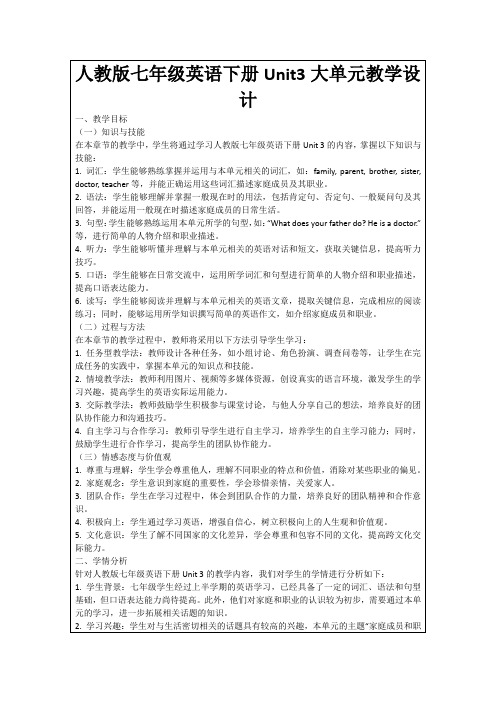
3.阅读理解:阅读与本单元主题相关的文章,完成相应的阅读理解题目,锻炼学生的阅读技巧和信息提取能力。
4.口语作业:准备一段关于自己家庭成员和职业的介绍,下节课进行课堂展示,要求使用本单元所学的句型和词汇,提高学生的口语表达能力。
5.合作意识:七年级学生正处于青春期,个性鲜明,合作意识相对较弱。教师应通过小组活动、角色扮演等形式,培养学生的团队协作能力和沟通技巧。
6.个体差异:学生在英语学习上存在一定的个体差异,教师需关注每个学生的学习状况,因材施教,使每个学生都能在原有基础上得到提高。
三、教学重难点和教学设想
(一)教学重难点
2.分步教学,逐步突破语法难点:
-通过对比一般现在时的肯定句、否定句和一般疑问句的结构,让学生观察、总结语法规则。
-利用图表、例句、练习等多种形式,帮助学生掌握一般现在时的用法,并通过小组合作、角色扮演等活动进行巩固。
3.互动交流,提升口语能力:
-采用问答、讨论等形式,鼓励学生用英语进行交流,提高口语表达能力。
1.重点:本单元的重点在于掌握一般现在时的用法,包括肯定句、否定句、一般疑问句及其回答,以及熟练运用与家庭成员和职业相关的词汇、句型进行交流。
2.难点:
-一般现在时的肯定句、否定句转换,以及一般疑问句的构成和回答。
-不同职业词汇的正确拼写和发音。
-口语表达中,正确使用本单元所学的句型和词汇描述家庭成员及其职业。
2.教师提出问题:“What does your father/mother do?”,让学生用英语回答,活跃课堂氛围,为新课的学习做好铺垫。
3.引入本节课的主题:“Let's talk about our family members and their jobs.”,让学生明确学习目标。
人教版七年级英语下册Unit3SectionB(2a2c)教学设计

3.利用图片和关键词,引导学生复习已学过的相关词汇,如:robots、traffic、pollution、clean等,为新课的学习做好铺垫。
(二)讲授新知
1.教师呈现一般将来时态的句子,如:“I will have a robot in the future.”,引导学生观察并总结一般将来时态的构成和用法。
2.通过对比一般现在时、一般过去时,让学生感知一般将来时态的特点,重点讲解“主将从现”的语法结构。
3.结合课本2a部分的内容,让学生听录音并跟读,加强对一般将来时态的语音、语调感知。
人教版七年级英语下册Unit3SectionB(2a2c)教学设计
一、教学目标
(一)知识与技能
在本章节的学习中,学生将掌握以下知识与技能:
1.能够熟练运用本节课所学的词汇,如:future、robots、traffic、pollution、clean等,并能在实际语境中进行运用。
2.能够掌握一般将来时态的用法,并能在句子中正确运用。
(1)一般将来时态在句子中的正确运用,特别是主将从现的语法结构。
(2)听力训练中,学生对较长、较复杂句子的理解。
(3)学生在口语表达中,如何将所学知识灵活运用到实际语境中。
(二)教学设想
1.创设情境,激发兴趣:通过展示未来科技发展的图片和视频,激发学生对未来生活的兴趣,为新课的学习营造氛围。
2.分步骤教学,循序渐进:
2.学生分享自己在课堂中的收获和感悟,教师给予肯定和鼓励。
新版人教版七下英语第3单元教案
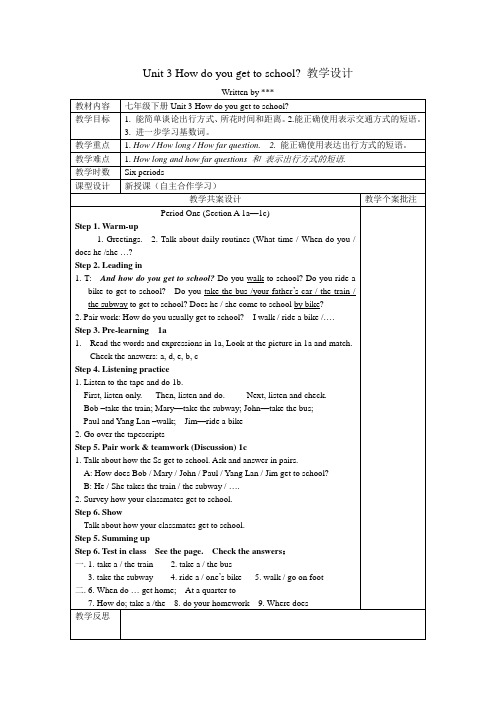
Step3.3a
Pre-learning. Read the questions and the answers. Do it alone.
Check the answers with your partner. Discuss your problems. c, e, d, a, b
1. Talk about how the Ss get to school. Ask and answer in pairs.
A: How does Bob / Mary / John / Paul / Yang Lan / Jim get to school?
B: He / She takes the train / the subway /….
二.11. How does 12. How long 13. How far14. How long does it take from your home to your grandparents’ (home) by bike?
教学反思
Unit3How do you get to school?教学设计
2. Pair work: How do you usually get to school?Iwalk / ride a bike /….
Step3. Pre-learning1a 1a,Look atthe picture in 1a and match.
Unit3How do you get to school?教学设计
Written by***
教材内容
七年级下册Unit3How do you get to school?
教学目标
七年级英语下册第三单元教案(新人教版).doc
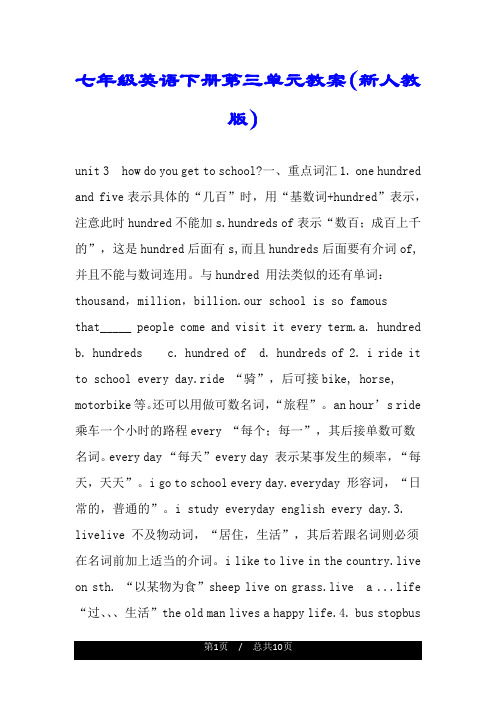
七年级英语下册第三单元教案(新人教版)unit 3 how do you get to school?一、重点词汇1. one hundred and five表示具体的“几百”时,用“基数词+hundred”表示,注意此时hundred不能加s.hundreds of表示“数百;成百上千的”,这是hundred后面有s,而且hundreds后面要有介词of,并且不能与数词连用。
与hundred 用法类似的还有单词:thousand,million,billion.our school is so famousthat_____ people come and visit it every term.a. hundred b. hundreds c. hundred of d. hundreds of 2. i ride it to school every day.ride “骑”,后可接bike, horse, motorbike等。
还可以用做可数名词,“旅程”。
an hour’s ride 乘车一个小时的路程every “每个;每一”,其后接单数可数名词。
every day “每天”every day 表示某事发生的频率,“每天,天天”。
i go to school every day.everyday 形容词,“日常的,普通的”。
i study everyday english every day.3. livelive 不及物动词,“居住,生活”,其后若跟名词则必须在名词前加上适当的介词。
i like to live in the country.live on sth. “以某物为食”sheep live on grass.live a ...life “过、、、生活”t he old man lives a happy life.4. bus stopbusstop与bus station 都是指“公342019--10unit 3 how do you get to school?一、重点词汇1. one hundred and five表示具体的“几百”时,用“基数词+hundred”表示,注意此时hundred不能加s.hundreds of表示“数百;成百上千的”,这是hundred后面有s,而且hundreds后面要有介词of,并且不能与数词连用。
人教版新目标七年级英语下册 Unit 3 教学设计
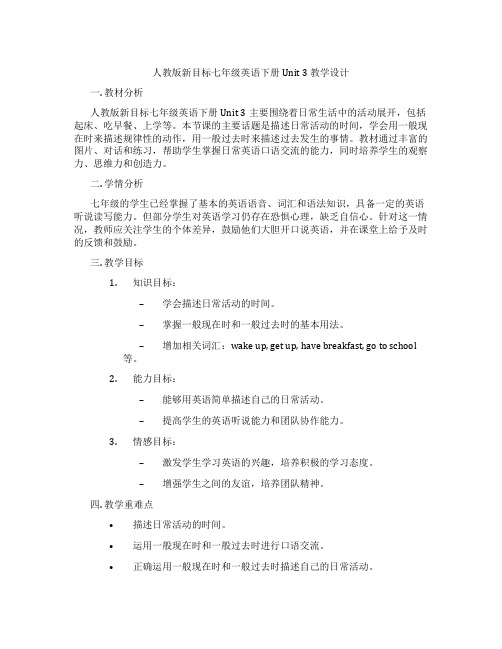
人教版新目标七年级英语下册 Unit 3 教学设计一. 教材分析人教版新目标七年级英语下册Unit 3主要围绕着日常生活中的活动展开,包括起床、吃早餐、上学等。
本节课的主要话题是描述日常活动的时间,学会用一般现在时来描述规律性的动作,用一般过去时来描述过去发生的事情。
教材通过丰富的图片、对话和练习,帮助学生掌握日常英语口语交流的能力,同时培养学生的观察力、思维力和创造力。
二. 学情分析七年级的学生已经掌握了基本的英语语音、词汇和语法知识,具备一定的英语听说读写能力。
但部分学生对英语学习仍存在恐惧心理,缺乏自信心。
针对这一情况,教师应关注学生的个体差异,鼓励他们大胆开口说英语,并在课堂上给予及时的反馈和鼓励。
三. 教学目标1.知识目标:–学会描述日常活动的时间。
–掌握一般现在时和一般过去时的基本用法。
–增加相关词汇:wake up, get up, have breakfast, go to school 等。
2.能力目标:–能够用英语简单描述自己的日常活动。
–提高学生的英语听说能力和团队协作能力。
3.情感目标:–激发学生学习英语的兴趣,培养积极的学习态度。
–增强学生之间的友谊,培养团队精神。
四. 教学重难点•描述日常活动的时间。
•运用一般现在时和一般过去时进行口语交流。
•正确运用一般现在时和一般过去时描述自己的日常活动。
•学会在适当的情境下使用一般现在时和一般过去时。
五. 教学方法1.情境教学法:通过设定生活情境,让学生在实际语境中学习、运用英语。
2.任务型教学法:引导学生参与各种小组活动,提高学生的团队协作能力和口语表达能力。
3.激励评价法:及时给予学生反馈,关注学生的点滴进步,激发学生的学习兴趣。
六. 教学准备1.教学素材:教材、多媒体课件、录音机、磁带、相关图片等。
2.教学工具:黑板、粉笔、投影仪等。
七. 教学过程1.导入(5分钟)–教师与学生用英语进行自由谈话,引导学生谈论日常活动。
–提问:What time do you get up? What do you have for breakfast? 让学生用英语回答。
人教版七年级下册英语Unit 3 教学设计

人教版七年级下册英语Unit 3 教学设计一. 教材分析人教版七年级下册英语Unit 3以“日常活动”为主题,通过介绍日常生活中的活动,让学生学会描述自己的日常安排和兴趣爱好。
本单元的核心词汇有play, watch, read, write, listen to, cook等,核心句型为“What do you do on…? I usually…”和“Do you like…? Yes, I do./ No, I don’t.”。
本单元旨在培养学生用英语进行简单交流的能力,提高他们的语言运用能力。
二. 学情分析七年级的学生已经掌握了基本的英语语法和一定数量的词汇,具备了一定的听说读写能力。
但部分学生在语言运用方面还存在一定的困难,特别是在口语表达和听力理解方面。
因此,在教学过程中,教师需要关注学生的个体差异,调动他们的学习积极性,引导他们主动参与课堂活动。
三. 教学目标1.知识目标:学生能够掌握本单元的核心词汇和句型,正确运用“Whatdo you do on…? I usually…”和“Do you like…? Yes, I do./ No, I don’t.”进行日常交流。
2.能力目标:学生能够在真实情境中运用英语描述自己的日常活动和兴趣爱好,提高他们的语言运用能力。
3.情感目标:培养学生对英语学习的兴趣,增强他们的自信心,使他们更加积极主动地参与课堂活动。
四. 教学重难点1.重点:学生能够熟练掌握并运用本单元的核心词汇和句型进行日常交流。
2.难点:学生能够在真实情境中运用英语描述自己的日常活动和兴趣爱好。
五. 教学方法1.任务型教学法:通过设计各种真实的任务,让学生在完成任务的过程中运用英语,提高他们的语言运用能力。
2.情境教学法:创设各种日常活动的情境,让学生在真实的情境中学习英语,增强他们的学习兴趣。
3.小组合作学习:学生进行小组讨论和合作,培养他们的团队精神和沟通能力。
六. 教学准备1.教材:人教版七年级下册英语教材。
人教版七年级英语下册第三单元同步教学设计
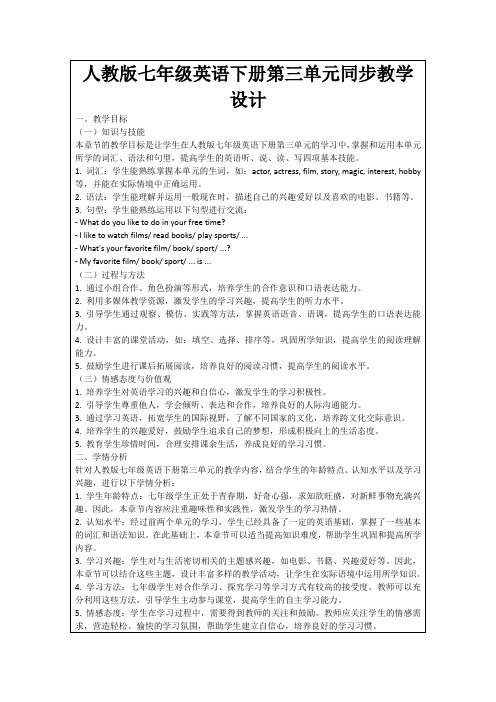
- My favorite film/ book/ sport/ ... is ...
(二)过程与方法
1.通过小组合作、角色扮演等形式,培养学生的合作意识和口语表达能力。
2.利用多媒体教学资源,激发学生的学习兴趣,提高学生的听力水平。
人教版七年级英语下册第三单元同步教学设计
一、教学目标
(一)知识与技能
本章节的教学目标是让学生在人教版七年级英语下册第三单元的学习中,掌握和运用本单元所学的词汇、语法和句型,提高学生的英语听、说、读、写四项基本技能。
1.词汇:学生能熟练掌握本单元的生词,如:actor, actress, film, story, magic, interest, hobby等,并能在实际情境中正确运用。
2.语法:一般现在时的用法是本章节的语法重难点。学生需要学会如何运用一般现在时描述自己的兴趣爱好、日常生活等。
3.口语表达:学生需要能够运用所学句型和词汇,流畅地进行话题讨论,表达自己的观点和喜好。
(二)教学设想
1.创设情境:利用多媒体展示电影片段、书籍封面等图片,激发学生的学习兴趣,引导学生主动参与课堂讨论。
2.语法:学生能理解并运用一般现在时,描述自己的兴趣爱好以及喜欢的电影、书籍等。
3.句型:学生能熟练运用以下句型进行交流:
- What do you like to do in your free time?
- I like to watch films/ read books/ play sports/ ...
4.口语练习:与家长或同学进行英语对话,讨论各自的兴趣爱好,要求使用所学句型和词汇。
(完整版)人教版七年级下册英语unit3教学设计
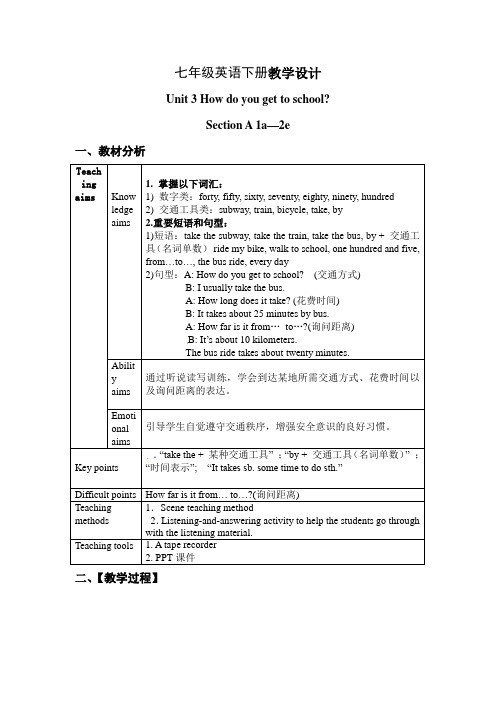
七年级英语下册教学设计Unit 3 How do you get to school?Section A 1a—2e一、教材分析1. 掌握以下词汇:1) 数字类:forty, fifty, sixty, seventy, eighty, ninety, hundred2) 交通工具类:subway, train, bicycle, take, by[2.重要短语和句型:1)短语:take the subway, take the train, take the bus, by + 交通工具(名词单数)ride my bike, walk to school, one hundred and five,from…to…, the bus ride, every day2)句型:A: How do you get to school? (交通方式)B: I usually take the bus.A: How long does it take? (花费时间)B: It takes about 25 minutes by bus.A: How far is it from…to…?(询问距离)[来B: It’s about 10 kilometers.The bus ride takes about twenty minutes..“take the + 某种交通工具” ;“by + 交通工具(名词单数)” ;“时间表示”; “It takes sb. some time to do sth.”How far is it from… to…?(询问距离)二、【教学过程】表示”“It takes sb. some time to do sth.Role-play the conversation.目的:巩固和运用先前输入的目标语言结构;提供完整的对话和真实的语境,供学生在模仿的基础上生成新的口语表达。
人教版七年级英语下册Unit3教案
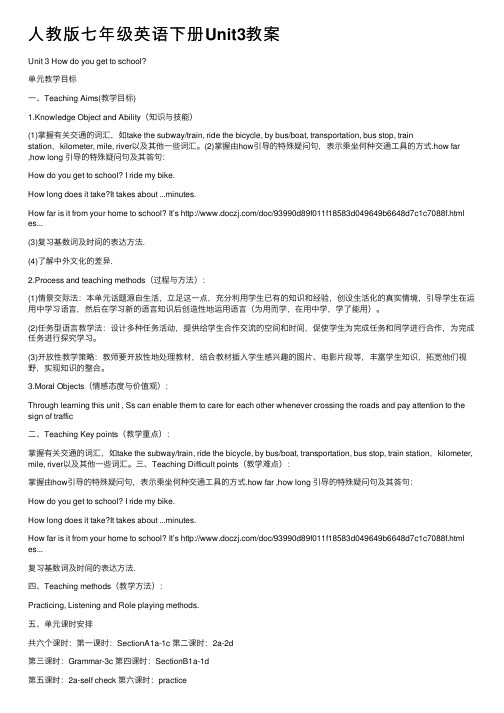
⼈教版七年级英语下册Unit3教案Unit 3 How do you get to school?单元教学⽬标⼀、Teaching Aims(教学⽬标)1.Knowledge Object and Ability(知识与技能)(1)掌握有关交通的词汇,如take the subway/train, ride the bicycle, by bus/boat, transportation, bus stop, trainstation,kilometer, mile, river以及其他⼀些词汇。
(2)掌握由how引导的特殊疑问句,表⽰乘坐何种交通⼯具的⽅式.how far,how long 引导的特殊疑问句及其答句:How do you get to school? I ride my bike.How long does it take?It takes about ...minutes.How far is it from your home to school? It’s /doc/93990d89f011f18583d049649b6648d7c1c7088f.html es...(3)复习基数词及时间的表达⽅法.(4)了解中外⽂化的差异.2.Process and teaching methods(过程与⽅法):(1)情景交际法:本单元话题源⾃⽣活,⽴⾜这⼀点,充分利⽤学⽣已有的知识和经验,创设⽣活化的真实情境,引导学⽣在运⽤中学习语⾔,然后在学习新的语⾔知识后创造性地运⽤语⾔(为⽤⽽学,在⽤中学,学了能⽤)。
(2)任务型语⾔教学法:设计多种任务活动,提供给学⽣合作交流的空间和时间,促使学⽣为完成任务和同学进⾏合作,为完成任务进⾏探究学习。
(3)开放性教学策略:教师要开放性地处理教材,结合教材插⼊学⽣感兴趣的图⽚、电影⽚段等,丰富学⽣知识,拓宽他们视野,实现知识的整合。
3.Moral Objects(情感态度与价值观):Through learning this unit , Ss can enable them to care for each other whenever crossing the roads and pay attention to the sign of traffic⼆、Teaching Key points(教学重点):掌握有关交通的词汇,如take the subway/train, ride the bicycle, by bus/boat, transportation, bus stop, train station,kilometer, mile, river以及其他⼀些词汇。
人教版英语七年级下册unit3-教案
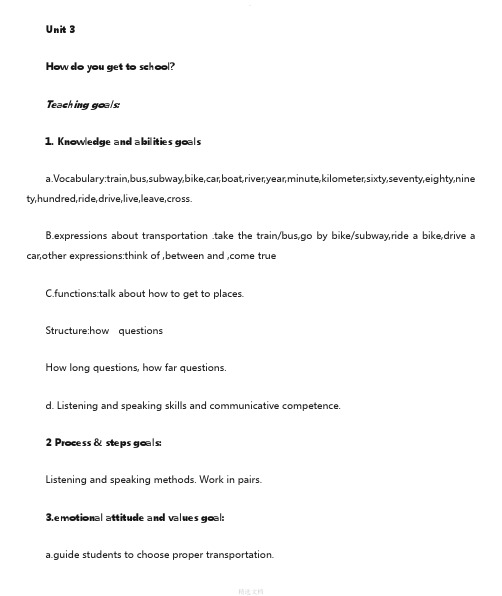
Unit 3How do you get to school?Teaching goals:1. Knowledge and abilities goalsa.Vocabulary:train,bus,subway,bike,car,boat,river,year,minute,kilometer,sixty,seventy,eighty,nine ty,hundred,ride,drive,live,leave,cross.B.expressions about transportation .take the train/bus,go by bike/subway,ride a bike,drive a car,other expressions:think of ,between and ,come trueC.functions:talk about how to get to places.Structure:how questionsHow long questions, how far questions.d. Listening and speaking skills and communicative competence.2 Process & steps goals:Listening and speaking methods. Work in pairs.3.emotional attitude and values goal:a.guide students to choose proper transportation.Develop students cooperative spirits and oral English.Key points and difficult points:Key points:how questionsHow long questions, how far questions.Difficult points:how questionsHow long questions, how far questions.Teaching procedures:Lesson 1sectionA (1a-2c)Step1:warm upListen and ss guess what transportation it isStep2 play a guessing game.Step3 show ss the pictures and phrases about transportation.Step4 ss look at the pictures about all kinds of vehicle and learn the phrases :take the train,take the bus,take the plane......Step5 Match the words with the pictures.Step6 ss role-play the dialogues in 1aStep7 look at the pictures and practice the sentences;how do you get to school?I take the subway.I get to school by the subway.Step8 ss finish 1b.Step9 ss make conversations about how to get to school.Step10 ss listen to tapes and finish the task in 2a and 2bStep 11 ss read the listening materials.Step12 ss use the information to make conversationsLesson 2 section A(2d-3c)Step1 students scan the conversation in 2e and fill in the chart.Step2 students role-play the conversation.ask some students to act out to see which group is the best.Step3 teacher explain the key words and phrases.and ask ss if they have any questions.Step4Read the sentences in grammar focus and ask ss to translate the Chinese sentences on ppt.Step5 guide ss to find the rules and character of the sentences .Teacher summarizes the grammar points.Step6Ss finish tasks in 3a and practice the dialogues.Step 7Ss finish the task in 3b.ask some students to present their answers.Step8 ss work in groups to finish the task in 3c.they fill in the chart .ask ss to present how they ask and answer.Lesson 3 section B(1A-2c)Step1 reviewShow ss pictures and ask them to make conversations.Step2 independent learningss read the phases in 1a. and then finish the task in 1a .Step3 check the answer of 1a .ss work with their partner to tell how they get to e two types of transportation..Step4 listen to tapes and finish the task in 1c ,listen again ,finish the task in 1d. teacher checks the answers.Step 5 ss work in pairs and ask and answer questions about Bob.Step6 ss look at the picture and title below,ss work in groups to talk about what the passage is about.Step 7ss read the article and answer the questions.Step8 ss read after the tape.and teacher ask ss to pay attention to their pronunciation.Step9 the teacher explains the key phrases and grammar of this article.Step10 ask ss to finish task in 2c.Lesson 4 section B(3A-self check)Step 1 ask ss to recite the passage in 2bStep2 ask ss if they have any questions on understanding the sentences,ask ss to fill in the blanks.Step 3 give ss 10 minutes to write an e-mail and tell how you get to school.Step4 summarize the grammar and key phrases in this unit.Home workFinish the self check Blackboard design。
人教版英语七年级下册Unit3大单元教学设计
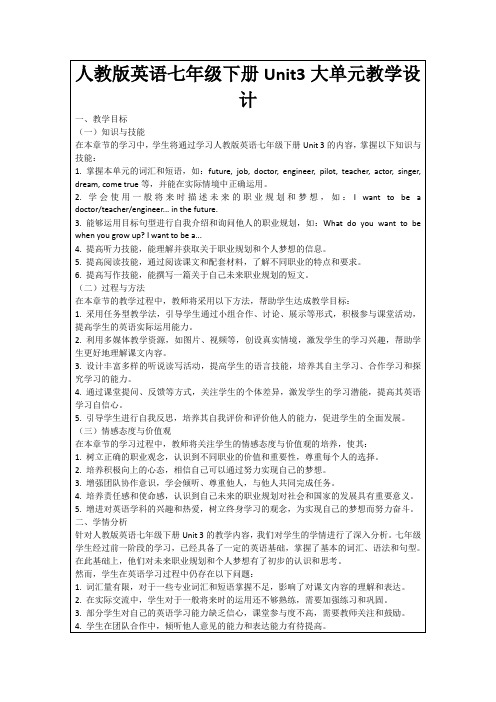
(二)教学设想
1.情境导入:通过展示不同职业的工作场景和人物访谈视频,激发学生对未来职业的好奇心和兴趣,为新课的学习营造积极的氛围。
2.互动教学:在课堂教学中,采用问答、小组竞赛、角色扮演等互动方式,提高学生的参与度和学习积极性。
2.教学内容:播放一段关于梦想的英文视频,引导学生思考自己的梦想。
过程设计:观看视频后,教师提出问题:“What is your dream job?”让学生思考并准备进行小组讨论。
(二)讲授新知
1.教学内容:学习本节课的核心词汇和短语,如:future, job, doctor, engineer, pilot, teacher, actor, singer, dream, come true等。
(三)学生小组讨论
1.教学内容:学生分组讨论,分享彼此的梦想和职业规划。
过程设计:教师将学生分成小组,让他们用英文讨论以下问题:“What do you want to be when you grow up? Why?”并选派代表进行汇报。
2.教学内容:小组讨论,探讨不同职业的特点、要求以及如何实现自己的梦想。
2.一般将来时的运用:正确使用一般将来时描述未来的职业规划和梦想是本章节的语法难点。
-教学设想:设计不同场景的对话和写作练习,让学生在模仿和创作中自然习得一般将来时的用法。通过对比、归纳和大量的口头练习,帮助学生内化语法知识。
3.听力理解和口语表达:学生需要在听力活动中获取职业规划的信息,并在口语交流中表达个人梦想。
6.跨学科融合:结合社会、科学等学科,让学生了解不同职业的特点、要求和发展趋势,拓宽视野,提高综合素养。
人教版英语七年级下册Unit3教学设计
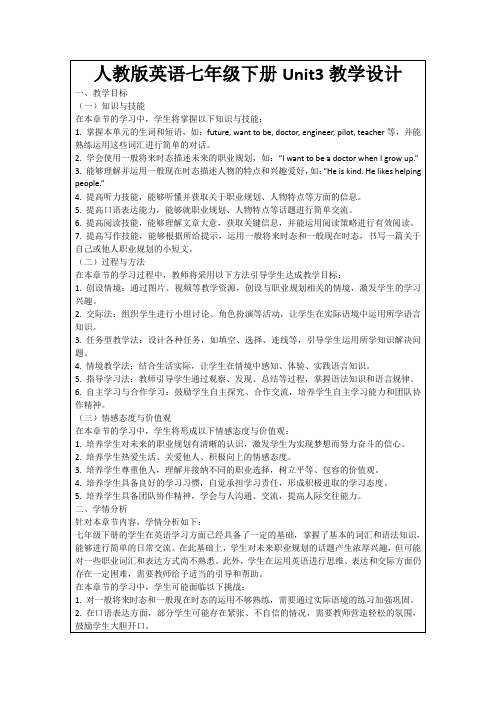
4.词汇练习:学生整理本节课所学的职业词汇,并用自己的话解释每个词汇的意思。然后,用这些词汇造句,展示对词汇的掌握。
例如:“My uncle is a doctor. He works at a hospital and takes care of patients every day.”
2.教师通过实例讲解,让学生理解并掌握两种时态的用法,如:
- “I will study hard to become a doctor when I grow up.”
- “He is kind and helpful. He likes taking care of animals.”
3.引导学生关注职业词汇和表达方式,如:future, want to be, doctor, engineer, pilot, teacher等。
2.口语练习:学生分组,每组选择一个职业进行角色扮演,运用本节课所学的词汇和表达方式,进行对话练习。要求每组将对话录制下来,并在下一节课前提交给教师。
例如:
- A: What do you want to be in the future?
- B: I want to be an engineer. I like solving problems and designing new things.
(五)总结归纳
1.教师引导学生回顾本节课所学内容,总结一般将来时态和一般现在时态的用法,以及职业词汇和表达方式。
2.学生分享学习心得,交流学习方法和技巧。
3.教师强调本章节的重点和难点,提醒学生注意在实际语境中灵活运用所学知识。
新人教版七年级英语下册Unit3 教案
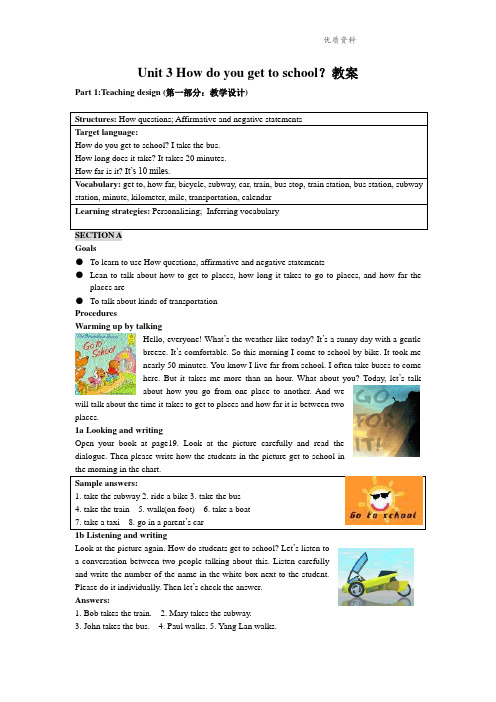
Unit 3 How do you get to school?教案Part 1:Teaching design (第一部分:教学设计)Structures: How questions; Affirmative and negative statementsTarget language:How do you get to school? I take the bus.How long does it take? It takes 20 minutes.How far is it? I t’s 10 miles.Vocabulary: get to, how far, bicycle, subway, car, train, bus stop, train station, bus station, subway station, minute, kilometer, mile, transportation, calendarLearning strategies: Personalizing; I nferring vocabularySECTION AGoals●To learn to use How questions, affirmative and negative statements●Lean to talk about how to get to places, how long it takes to go to places, and how far theplaces are●To talk about kinds of transportationProceduresWarming up by talkingHello, everyone! What’s the weather like today? It’s a sunny day with a gentlebreeze. It’s comfortable. So this morning I come to school by bike. It took menearly 50 minutes. You know I live far from school. I often take buses to comehere. But it takes me more than an hour. What about you? Today, let’s talkabout how you go from one place to another. And wewill talk about the time it takes to get to places and how far it is between twoplaces.1a Looking and writingOpen your book at page19. Look at the picture carefully and read thedialogue. Then please write how the students in the picture get to school inSample answers:1. take the subway2. ride a bike3. take the bus4. take the train5. walk(on foot)6. take a boat7. take a taxi 8. go in a parent’s car1b Listening and writingLook at the picture again. How do students get to school? Let’s listen toa conversation between two people talking about this. Listen carefullyand write the number of the name in the white box next to the student.Please do it individually. Then let’s check the answer.Answers:1. Bob takes the train.2. Mary takes the subway.3. John takes the bus.4. Paul walks.5. Yang Lan walks.TapescriptA: How do Bob and Mary get to school?B: Bob takes the train and Mary takes the subway.A: How does John get to school?B: He takes the bus.A: How do Paul and Yang Lan get to school?B: They walk. Look, there they are waling now!Now read the tapescript, shadow the how questions and underling the expressions.1c Doing pairworkPlease read the dialogue on page 19 in the box. And make your own conversations about how the’ll ask some pairs to say their dialogue. Sample dialogueA: How does Bob get to school?B: He takes the train.A: Does John take the train to school, too?B: No. He takes the bus.A: What aboutMary and Paul?B: Paul walks,and Mary takes thesubway.A: And Yang Lan walks, does she?B: Yes, she does.2a Listening and repeatingListen to these numbers and repeat. Please pay attention to the pronunciation.Tapescript32, 40, 50, 60, 70, 80, 90, 100forty-six 46 thirty-three 33 seventy-two 72one hundred and five 105 fifty-eight 58 ninety-nine 99sixty-one 61 eighty-four 84Now please look at the five transportation pictures. And we’ll listen to two conversations. The people are talking about how students get to school and how long it takes. Listen carefully and put a checkmark to show the kinds of transportation they talk about. Check your answer.40 minutes 35minutes25minutes10 minutesListen carefully again and match the time with the kinds ofTapescriptConversation 1Boy: How do you get to school?Girl: I take the train.Boy: How long does it take?Girl: Oh, around forty minutes. How aboutyou?Boy: I take the subway.Girl: How long does that take?Oh, around thirty-five minutes.Conversation 2Girl: How do you get to school, Tom?Tom: I ride my bike.Girl: How long does it take?Tom: It takes around twenty-five minutes.Tom: How do you get to school?Girl: I walk.Tom: And how long does that take?Girl: It only takes ten minutes.Look at the sentences on the board. “They take the train. It takes about forty minutes.”“Take the train” means to ride the train. And we also use “take” to talk about a length of time. For example, it takes me 20minutes to get to school. So we use the same word, take, in two different ways. Now read the tapescript, shadow the how questions and underling the expressions.2d Doing pairworkNow please make your own conversations about how you get to school and how long it takes.Example:A: How do you get to school?B: well, I usually walk but sometimes I take the bus.A: How long does it take?B: It takes about 25 minutes to walk and 10 minutes by bus. What about you? A: I get to school by bike, sometimes I take my father’s car.B: Oh, how long does it take?A: It takes around 40 minutes by bike and 15 minutes by car.3a Reading and writingSo far you have learned to talk about how you get to school and how long it takes.The passage you will learn in this part tells us something about Li Lei. Pleaseread the questions about Li Lei in the speech bubbles. Then read the passage andwrite the answers to the questions on the line. You should complete the activityindividually.1How does he 2 How long does 3 How far is it fromget to school? it take? his home to school?By bike and It usually takes About 10 kilometers.by bus. about 35 minutes.Now read the passage following the tape sentence by sentence. Please pay attention to the pronunciation and intonation of the native readers and try to imitate them. Then draw lines under the useful phrases and structures.Lin Fei’s home/ is about 10 kilometers /from school. He gets up /at six o’clock/ every day, showers, and has a quick breakfast. Then/ he leaves for school/ at around six-thirty. First, he rides his bicycle/ to the bus station. That takes about ten minutes. Then/ the early bus/ takes him to school. The bus ride/ usually/ takes about 25 minutes.school? What time do you get up? How do you get to school? Let’s ask some students to say something about you.3b Doing pairworkLook at the pictures on page 21. Can you name each form of transportation? They are easy to you. Read the time and distance that goes with each form of transportation. Pay attention to “mile”, which is a common measure of distance in some western countries. (1 mile=1.6 kilometers). Read the example dialogue in the box.A: How do you get to school?B: I take the train.A: How far is it from your home to school?B: It’s eight miles.A: How long does it take you to get from home toSchool ?B: It takes 35 minutes.A: How do you get to school?B: I walk.A: How far is it from your home to school?B: It’s two miles.A: How long does it take you to get from home to school ?B: It takes 40 minutes.A: How do you get to school?B: I take the bus.A: How far is it from your home to school?B: It’s four miles.A: How long does it take you to get from home to school?B: It takes 15 minutes.4 Talking and writingWell done everyone! Now let’s play a game: Info Gap Race! This time you work in groups of three. You decide which one is A, which one is B and which one is C. Please read the instruction. You ask each other questions to learn information for your chart, and then write the answers on the chart in your book. Don’t look at others’ pages please. The first group to fill in all the blanks is theWho How How long How far1. Maria bus twenty minutes five miles2. John bike ten minutes six miles3. Liu Pei subway fifteen minutes eight milesC:How does Maria get to school?A: She takes the bus. How long does it take Maria to get to school?B: It takes her twenty minutes. How far is it from her home to school?C:It’s five miles.Closing down by asking and answering(using the useful information learned in this part)*How do you get to school?*I usually walk, but sometimes I take the bus.*How long does it to take you to get from your home to school?*It takes 25 minutes.*How far is it from your home to school?*It’s around 4miles. A bus station Section BGoals●To learn to use: bus stop, train station, subway station●To learn to talk about how to get to places further.ProceduresWarming up by asking some individuals questionsHow does Li Lei get to school? First, he rides his bicycle to the bus station. Then he takes the early bus to school. Do you know the bus station? It’s a place where trains stop here. Today we’ll study some other “stations”.1a Looking and matchingLook at the four phrases on the top of page 22 and read them loudly. Then match the words withAnswers: 1. b bus stop 2. a train station 3. c bus station 4. d subway station1b Doing pairworkRead the dialogue in the box first. Then suppose you use two kinds of transportation to get to school. Now make your own dialogues to tell your partner how you get to school, using theSample dialogue:A: How do you get to school?B: Well, I ride my bike to the subway station. Then I take the subway. What about you?A: First, I walk to the bus stop. Then I take the bus to school.A: How does your father get to his school?B: Well, he walks for ten minutes to Bus No. 11. He takes the bus and gets off at Da Yingpan. Then he walks again for five minutes to his classroom.2a Listening and checkingOK, now. Let’s listen to the conversation between Tina and Thomas. What does Thomas want to know about Nina? Here is a list of information that Thomas wants to know. I’ll ask some students to read lines to the class. Then listen carefully and put a checkmark in front of each thing thatThomas wants to know…√where Nina lives.how far from school she lives.how long it takes Nina to get to school.√how she gets to school.what she thinks of the transportation.2b Listening and checkingLook at the pictures on page 22 with a blank line in front of each. They show the ways of how to get to school. Which one is Nina’s? Listen carefully and put a checkmark next to the picture that shows how Nina gets to school.1.—to ride a bike to the subway—to take the subway tothe bus—to walk from the bus stop to the school2.√to walk to the bus—to take the bus to the subway—totake another bus after the subway—to walk from the busTypescriptThomas: Where do you live, Nina?Nina: New Street.Thomas: So, how do you get to school?Nina: Well, first I walk to the bus stop.Thomas: Uh-huh.Nina: I take a bus to the subway station. Then I take the subway.Thomas: Yeah…Nina: Next I take a bus to the bus stop on 26thStreet. Finally I walk.You may turn to the tapescript to read it, underlining theexpressions and shadowing the how questions.2c Doing groupworkNow make your conversations about how Nina gets to school in groups of four. You can use the pictures in activity 2b. Pay more attention to the sentence starters: S he…; Next, she…; Then, she…Sample dialogue:A: How does Nina get to school?B: She walks to the bus stop.C: Next, she takes a bus to the subway station.D: Then she takes another bus to the bus stop on 26th street after the subway.A: Finally she walks to school.Now let’s ask some of you to say your descriptions to the class.3a Reading and writingNow you can say something about how you get to school.Do you want to know how students around the world get to school? Read the article on page 23, and then decide if the statements are true or false in your exercise book.Check the answers:T 1. In North America, not all students take the bus to school.T 2. Other parts of the world are different from the United States.F 3. In Japan, the three most popular ways of getting to school are bus, train and bike. (Students take trains, or walk, or ride bikes)F 4. In China, bikes and buses are the most popular means of transportation. (It depends on where you are)T 5. Students in Hongshanhu and Kaishandao have to take a boat to get to school.Read the article once again, this time, to slash/ the sentences, underline the useful expressions in it and shadow the connectives. After school, you are going to write them down in your notebook. How do students around the world get to school?In North America, most students/ go to school/ on the school bus. Somestudents/ also walk/ or ride bikes to school. In other parts of the world,things are different. In Japan, most students/ take trains to school,although others also walk/ or ride their bikes. In China, it depends on /where you are. In big cities, students usually ride bikes to school/ or take buses. And in places/ where there are rivers and lakes, like Hongshanhu and Kaishandao, students usually go to school/ by boat. That must be a lot more fun/ than taking a bus!3b Reading and writingLook at the chart. Then read the article and fill in the blanks. You can findthe answers in the chart. Please complete the activity individually.How do the students get to Garden High School?At Garden High School, most students ride their bikes to school. Many students walk. Some students drive. Other students take the bus. A small number of students take the subway.3c WritingJust now we filled in an article about how students get to Garden High School. What about you?How do students in our class get to school? Let’s make a survey and listyour ideas on the board. You can use the words and numbers to write apassage about how students in our class get to school.Sample passage:In my class, most students ride their bikes to school. Many students go to school on foot. Some students live far from school, so they go to school by bus. A few students take their parents' car to school.At Taiyuan Wuzhong, most students live at school. They just walk to their classroom. So they don’t ride their bikes to school. Many students play on the playground in the early morning. Some students play football. Some read aloud their English texts. But at the same time, other students in other schools have to take the bus, ride the bike, to hurry to their schools.4 Making a surveyNow turn to page 82, please. Look at the chart. Read the heading and the phrases listed below.Please complete the chart in ten minutes. You can go around the class and ask questions to find out the answers. Look at the dialogue in the box next to the chart. You can ask questions like this.Find someone who…Nameslives 10 miles away from school.walks to school.takes a bus to school.takes more than an hour to get to school.ride s a bike to school.takes the subway to school.takes less than ten minutes to get to school.Do you remember Nina? How does she get to school? How do students around the world get to school? Please tell me in your own words. And I will also ask some of you to say something about themselves. Who will be the first to have a try?SELF CHECKGoals●To revise the vocabulary introduced in the unit●To practice writing skillProcedures1 Filling the blanks and making sentencesLook at part 1 on page 24. Fill in the blanks with the words given to you. Change the form of the word if necessary.Check the answers:1.How do you get to school in the morning?2.What do you think of the transportation in your town?3.When it rains I take a taxi.4.How far do you live from the bus station?5.I like to ride my bike on the weekend.Now make your own sentences with the words. I’ll ask some students to write the answers on the1.When will you get to Beijing?2.I cannot think of any good methods to learn English.3.I take a plane to go to my school in Shanghai.4.My teacher lives close to the school.5.I never ride a bike in life. But I like riding horses sometimes.Saturday SundayMorning: go to visit Mt. WutaiMorning: take a bus around the city, goshopping at supermarketsAfternoon: visit Jinci Afternoon: go around Pingyao City Evening: watch Jinju at a therter Evening: fly home from TaiyuanJust for fun!Let’s sing a song in English.Three Blind MiceThree blind mice, see how they run!They all ran after the farmer's wife,Who cut off their tails with a carving knife,Did you ever see such a thing in your life,As three blind mice?Part 2: Teaching resources(第二部分:教学资源)I. Background reading1.Traffic in EnglandWhen you are in England, you must be very careful in the streets because the traffic drives on the left.Before you cross a street, you must look to the right first and then the left.If the traffic lights are red, the traffic must stop. Then people on foot can cross the road carefully. If the traffic lights are green, the traffic can go. People on foot mustn't cross. In the morning and in the evening when people go to or come from work, the streets are very busy. Traffic is the most dangerous then.When you go by bus in England, you have to be careful, too. Always remember the traffic moves on the left. So you must be careful. Have a look first, or you will go wrong.In many English cities, there are big buses with two floors. You can sit on the second floor. From there you can see the city very well. It's very interesting!III. Word studies (词语学习)1.takev.1.抓住拾起get hold of something or someone; pick something up: Please take my hand. 请拉住我的手。
七年级下册英语Unit3单元教案(人教版)
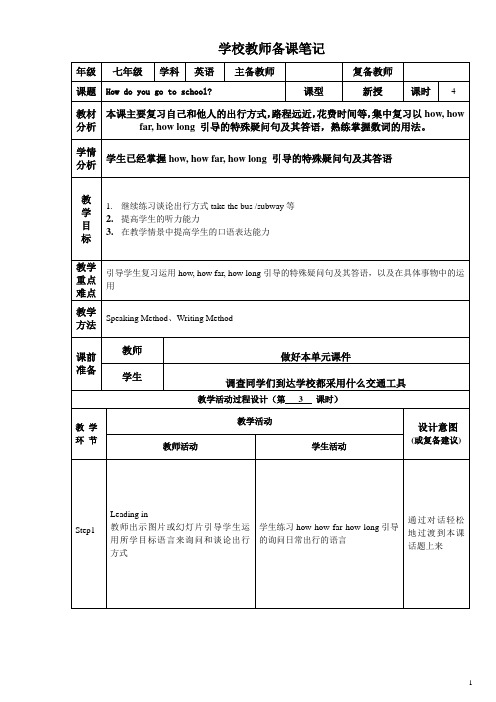
教师
做好本单元课件
学生
调查同学们到达学校都采用什么交通工具
教学活动过程设计(第3课时)
教学
环节
教学活动
设计意图
(或复备建议)
教师活动
学生活动
Step1
Leading in
教师出示图片或幻灯片引导学生运用所学目标语言来询问和谈论出行方式
学生练习how how far how long引导的询问日常出行的语言
3.Target language: How do you get to school?
I walk. take the bus, take the train
教学重点难点
1.The special questions:how /how far /how long…?
2.The expression of choosing different kinds o f transportation/.
板
书
设
计
Unit3 How do you get to school?
Period3(SectionB1a-1e)
重点词汇:bus stop, bus station, subway station, think of
重点语法:一般现在时(由How how long how far引导的特殊疑问句)
5. Act out their dialogues .
Read the phrases and words in 1a
Listen to the tape and finish 1b
read the numbers following the teachers
listen to the tape and finish 2b
新人教版七年级英语下册第三单元教案参考
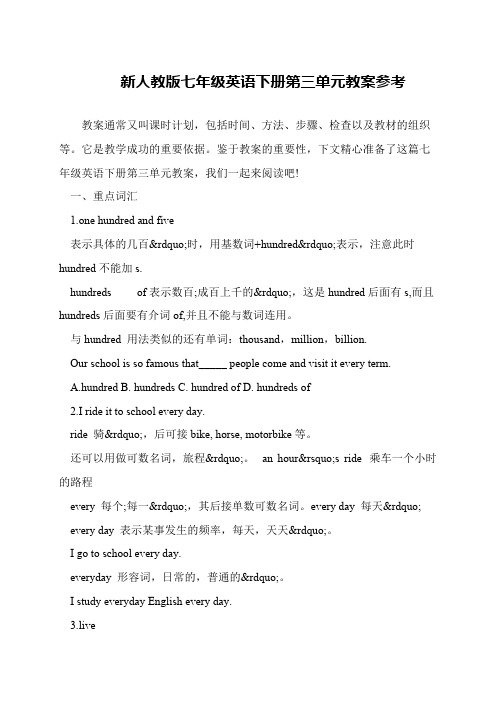
新人教版七年级英语下册第三单元教案参考教案通常又叫课时计划,包括时间、方法、步骤、检查以及教材的组织等。
它是教学成功的重要依据。
鉴于教案的重要性,下文精心准备了这篇七年级英语下册第三单元教案,我们一起来阅读吧! 一、重点词汇 1.one hundred and five 表示具体的几百”时,用基数词+hundred”表示,注意此时hundred不能加s. hundreds of表示数百;成百上千的”,这是hundred后面有s,而且hundreds后面要有介词of,并且不能与数词连用。
与hundred 用法类似的还有单词:thousand,million,billion. Our school is so famous that_____ people come and visit it every term. A.hundred B. hundreds C. hundred of D. hundreds of 2.I ride it to school every day. ride 骑”,后可接bike, horse, motorbike等。
还可以用做可数名词,旅程”。
an hour’s ride 乘车一个小时的路程 every 每个;每一”,其后接单数可数名词。
every day 每天” every day 表示某事发生的频率,每天,天天”。
I go to school every day. everyday 形容词,日常的,普通的”。
I study everyday English every day. 3.live。
- 1、下载文档前请自行甄别文档内容的完整性,平台不提供额外的编辑、内容补充、找答案等附加服务。
- 2、"仅部分预览"的文档,不可在线预览部分如存在完整性等问题,可反馈申请退款(可完整预览的文档不适用该条件!)。
- 3、如文档侵犯您的权益,请联系客服反馈,我们会尽快为您处理(人工客服工作时间:9:00-18:30)。
Unit 3. How do you get to school?一、考点、热点回顾【语法】1.交通方式表达法(1)用“by + 交通工具名词”表示交通方式。
此时交通工具的名词只能用单数,不能用复数,也不能被冠词或物主代词等限定。
如:by bike, by bus, by train, by ship, by planeThey often go home by bus.(2)用“by + 交通路线的位置”表示交通方式。
如: by land, by water, by sea, by airThey go to England by air.(3)用“in/on+ 交通工具名词”。
此时交通工具名词前必须有冠词、名词所有格形式或形容词性物主代词等限定词修饰。
其用法与“by+ 交通工具名词”He often goes to school on a (his) bike.(4)用“take a/the+ 交通工具名词”表示交通方式。
如:take a bus, take a train, take a ship, take a plane, ride a bikeWill you take a bus to go there?(5)表示“步行去某地”,a)go to +某地+on foot 如:She goes to work on foot.b)walk to +某地(walk to 后接地点副词here, there, home时,介词to 要省去)如:He walks to school every day.I usually walk home.【练习】(1). ——_____ do you get to the zoo?——Take the bus.A. WhatB. HowC. WhichD. When(2). 你通常怎么到学校?______do you usually _____ to school?(3).——______ _____ is it ______ your home ______ the hospital? 从你家到医院有多远?——It’s about three kilometers. 大约有3千米远。
(4) Allan will go back to England by plane next month. (就画线部分提问)_____ _____ Allan go back to England next month?2.不一样的“到达”:get to, reach, arrive in/atget 是不及物动词,当后面接表示地点的名词时应和介词to连用,但如果是接here, there 等地点副词时,应省略to.reach是及物动词,后面可以直接跟名词arrive是不及物动词,后面接大地点时,用arrive in, 接小地点时,用arrrive at. 但当接here, there 等地点副词时,不用介词。
【练习】(1) With the help of the Internet, news can _____ every corner of the word.A. arriveB. reachC. goD. get(2) They arrived ______ London on the morning of July 2nd.A. atB. inC. onD. to(3) They _____ the station at 7:00 yesterday morning.A. getB. get toC. got toD. got3.学会hundred的用法hundred是数词,意为“一百”,当我们表示几百时,用基数词+hundred。
注意此时hundred不加s, 也不带of.例:There are eight hundred students in our school.当表示笼统的概念数百时,常在词尾加-s,而且和of连用。
前面不能有数词例:There are hundreds of people in the restaurant.【扩展】类似用法的数词还有thousand千, million百万,billoin十亿【练习】(1)有数百人参加运动会___________ ____________people take part in the sports meet.(2) Tom spent two ________ and fifteen dollars on that yellow coat.A. hundredsB. hundredC. hundreds ofD. hundred of例:It took us 10 minutes to go to the station.Mr. Brown spent most of his money on books. / in buying booksThe coat cost me 100 yuanHe paid her 10 yuan for this book.【练习】:用take, spend, cost, pay的适当形式填空(1) 写那本书花了他两年半的时间。
It _____ him two years and a half to write the book.(2) 你们得在口语上花更多时间。
You have to _____ much more time on spoken English.(3) 那些书花了我200元钱。
Those books ______ me two hundred yuan.(4) 你付你的厨师多少报酬?How much did you ______ your cook?(5) How much does the ticket _____ from Shanghai to Beijing?A. costB. takeC. spendD. pay(6) It_____ me half an hour ______ my homework every day.A. takes; doB. takes; to doC. spends; doD. spend; doing5. 揭开stop 的面纱stop做名词时,意为:车站做动词时,意为:停止,阻止常见句型结构:stop doing sth.停止做某事Stop to do sth. 停止,中断做某事然后去做另一件事。
【练习】(1) Let’s stop _____. I know a good restaurant near here.A. to have a mealB. to have a restC. having a restD. having a meal(2) Please stop _____ and listen to the teacher.A. readB. to readC. readsD. reading(3) Today the forests have almost gone. We must stop people from _____ too many trees.A. cutB. to cutC. cuttingD. cutting6. 部分否定not allnot all这个结构表示的是“部分否定”,意为:并不是所有的...都.当not 用于代词all, many, much,every, both 前时,均属于部分否定。
例:Not all students are good at maths. 并非所有学生都擅长数学。
【延伸】:当表示全部否定时,用none.例:None of the answers are/is right. 没有一个答案是对的。
【练习】(1) 他们中没有一个是中国人。
_____ ______ ______ are Chinese.(2) 并非一切都好。
______ ______ is OK.(3) Xiao Li is the right person to show the foreigners around, for_____ of us can speak English.A. allB. eachC. bothD. none7. 重点句型:What do you think of ….?What do you think of ….是用来询问某人对某事或某人的看法的交际用语。
也可以说how do you like...?例:What do you think of Joan? 你觉得琼怎么样?【练习】(1) ——What do you think of the baseball match?——______.A.Our team lost the matchB. I didn’t hear of itB. C. It was very exciting D. Our team was a good one(2) ——What do you think of this film?——______.A. It’s wonderfulB. Not at allC. Got ideaD. With pleasure(3) ——_______ do you like the film? ——Very interesting.A. HowB. WhoC. WhatD. When8. 生活中有太多的“if”If 引导的条件状语从句,如果主句是一般将来时,祈使句或含有情态动词,条件状语从句一般用一般现在时。
例:We’re leaving for shanghai if it doesn’t rain tomorrow.I can see the doctor quickly if i get there earlyPlay basketball with me if you finish your homework.注意:从句一般放在主句的后面,若放句首要加逗号隔开。
【练习】(1) ——Mary, what about going boating if it _____ tomorrow?——Good idea!A. not rainB. rainC. rainsD. doesn’t rain(2) You can ask the teacher for help ______ you don’t know the answer.A. whereB. whoC. ifD. What用括号内所给单词(词组)的适当形式填空。
